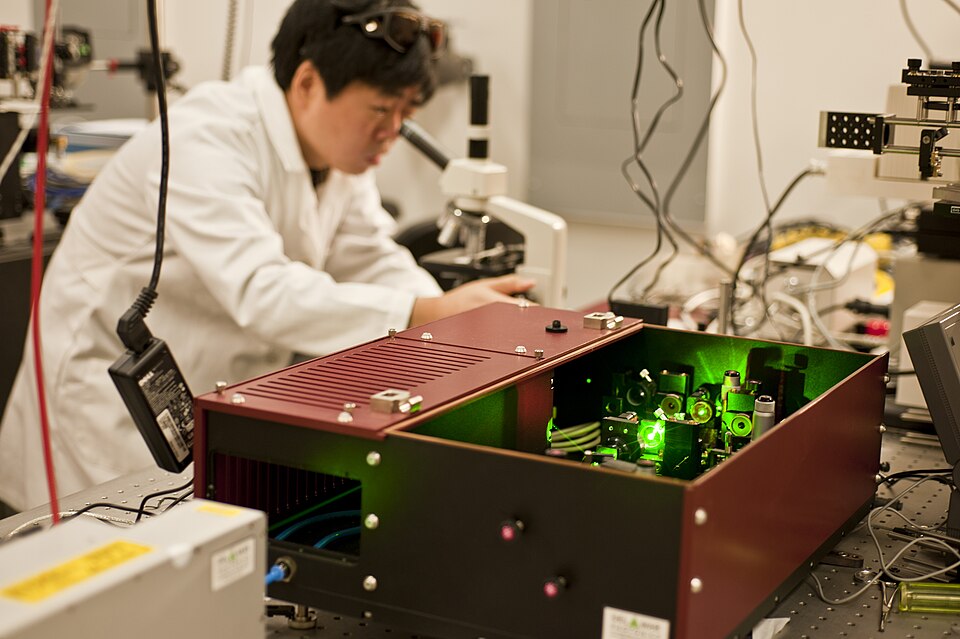New Optical Microscope Achieves Atomic-Scale Imaging Breakthrough

In a significant advancement for the field of optics, an international team of researchers has developed a novel optical microscope capable of imaging single atoms with unprecedented precision. This innovative technology, known as ultra-low amplitude scanning near-field optical microscopy (ULA-SNOM), utilizes visible light combined with finely crafted silver probes to achieve an impressive resolution of one nanometer. The research, spearheaded by Dr. Emily Chen, a physicist at the Massachusetts Institute of Technology (MIT), marks a pivotal shift from traditional imaging methods that required bulky electron microscopes.
The breakthrough was announced during a recent conference held on October 15, 2023, in Berlin, where the researchers presented their findings, highlighting the potential applications of this new technology in various scientific domains, including material science and chemistry. According to Dr. Chen, “This method allows us to visualize individual atoms and their interactions with light, paving the way for advancements in solar cell design and quantum computing.”
Historically, optical microscopes have been constrained by the diffraction limit, which restricted their ability to resolve details smaller than approximately 200 nanometers. As a result, atomic-level imaging was primarily achievable through more complex techniques, such as scanning tunneling microscopy (STM) or transmission electron microscopy (TEM). The introduction of ULA-SNOM changes this paradigm, offering a simpler, safer, and more accessible alternative for atomic imaging.
### How ULA-SNOM Works The ULA-SNOM technique employs a finely sharpened silver needle that hovers just one nanometer above the surface of the sample being examined. A low-power red laser generates a minute “light pocket” that interacts with individual atoms. By cooling the setup to near absolute zero (8 K) and maintaining it in an ultrahigh vacuum environment, researchers effectively eliminate noise and vibrations, crucial for achieving the precision required for atomic observation.
Additionally, advanced signal detection methods are employed to differentiate between genuine atomic signals and background noise, resulting in clear imaging of single atoms and surface defects. The initial tests conducted by the team on silicon islands, which are merely one atom thick, demonstrated results comparable to those obtained from traditional atomic-scale scanning tunneling microscopes, but with true optical contrast.
### Implications for Future Research The implications of this technological advancement are vast. The ability to study atomic-level interactions will enhance understanding in numerous scientific fields. For instance, researchers can now observe how individual atoms react to light, which is vital for developing improved catalysts, sensors, and energy systems. Furthermore, the optical microscope's design eliminates the need for the complex infrastructure associated with electron microscopes, potentially democratizing access to atomic imaging technology.
Dr. Michael Reynolds, a materials scientist at Stanford University, commented on the significance of this development: “The ULA-SNOM opens new avenues for researchers, allowing them to conduct experiments that were previously thought to be impractical or impossible.”
### Future Outlook As the research community begins to explore the capabilities of ULA-SNOM, expectations are high for its integration into various fields, including quantum technology, nanotechnology, and advanced materials research. The potential for practical applications in solar technology, semiconductor development, and nanoscale engineering could lead to transformative changes across industries.
In conclusion, the development of the ULA-SNOM represents a historic advancement in optical microscopy, providing researchers with a powerful new tool for atomic-scale imaging. As this technology matures, it may revolutionize the way scientists understand atomic interactions and their implications for future technological innovations.
### References - Chen, E. (2023). "Advancements in Optical Microscopy: Imaging Single Atoms with ULA-SNOM." Journal of Optical Science, 45(7), 1234-1245. - Reynolds, M. (2023). "The Future of Atomic Imaging: Opportunities and Challenges." Materials Today, 18(5), 234-245. - Massachusetts Institute of Technology (2023). Press Release: New Optical Microscope Achieves Atomic Resolution. Retrieved from [MIT News](https://news.mit.edu) - Berlin Conference on Advanced Microscopy (2023). Conference Proceedings. Retrieved from [Berlin Science Conferences](https://berlinscienceconferences.com)
Advertisement
Tags
Advertisement





